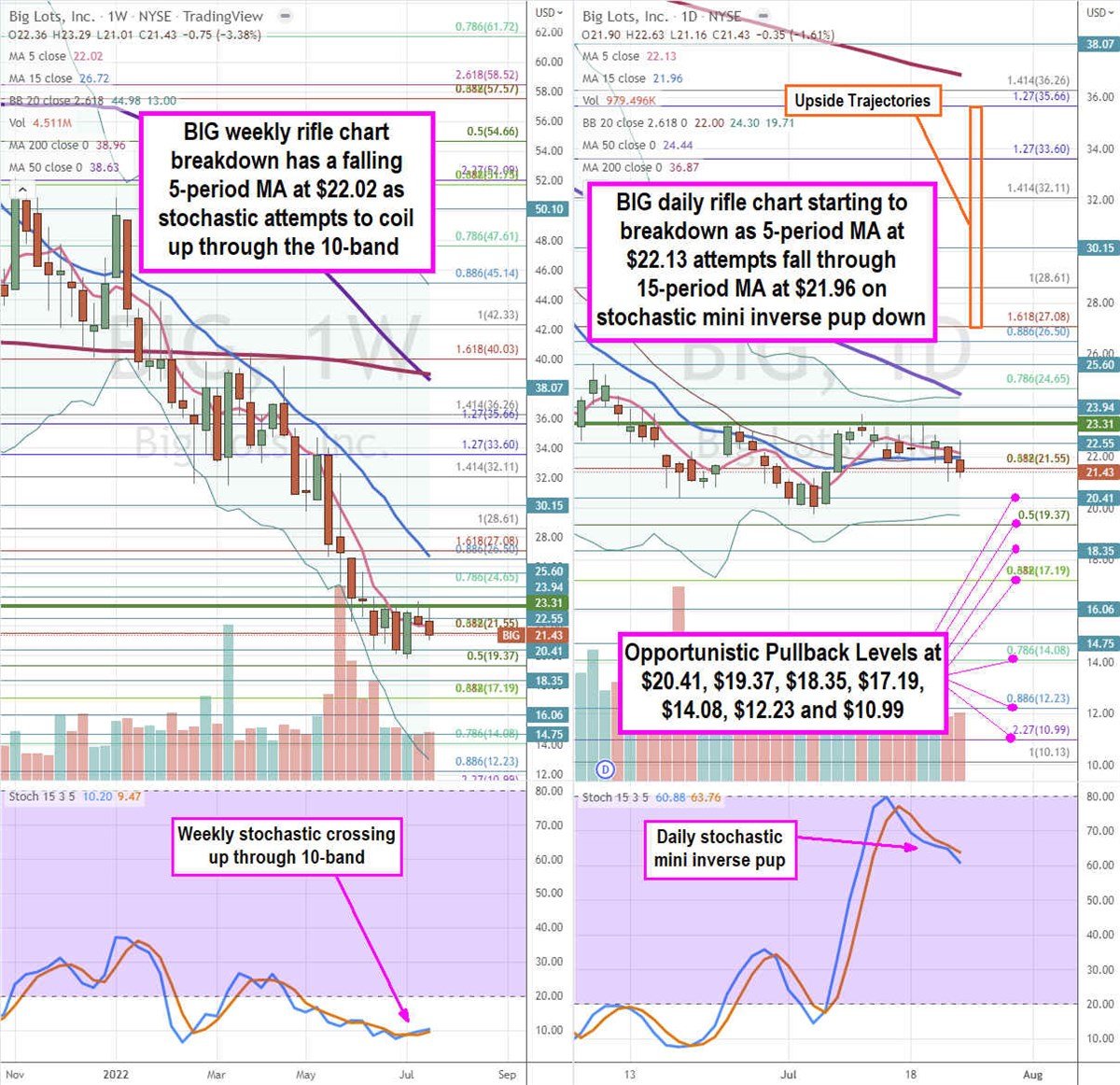Big Lots Stock is a Value Play at These Levels Home discount retailer Big Lots (NYSE: BIG) stock has tanked (-54%) in 2022. The Company was a benefactor during the pandemic as consumers spent buoyantly on home improvement items.
By Jea Yu
This story originally appeared on MarketBeat

Home discount retailer Big Lots (NYSE: BIG) stock has tanked (-54%) in 2022. Low consumer confidence and declining spending took a toll on the discount home furnishings retailer. The Company was a benefactor during the pandemic as consumers spent buoyantly on home improvement items. However, the reopening and macroeconomic conditions have led to a dramatic slowdown. Cost and labor inflation, logistics, and supply chain disruption were some of the headwinds that did a number of its fiscal Q1 2022 results. Broad inflation and rising gas prices started to impact consumer discretionary income levels starting in April. The COVID lockdowns in China worsened its supply chain issues as it procures a large amount of merchandise from there. On March 15, 2022, Big Lots received a letter from activist investor and 5% owner Mill Road Capital insistent on pursuing a sales process to maximize the present value of $55 to $70 per shares. The Company continues to grow its private label brands Broyhill and Real Living and expects to open over 500 units in the next five years. The softening consumer demand has left the Company over-inventoried with starting prices too high. The CEO assures this will be rectified which should help produce a second half improvement. While Target (NYSE: TGT) and Walmart (NYSE: WMT) also reported the unexpected drop in consumer spending, Big Lots has deep experience in closeout and discounting which will help it keep steady moving forward. Prudent investors looking for exposure in the discount home furnishings segment at a value can watch for opportunistic pullbacks in shares of Big Lots.
Fiscal Q1 2022 Earnings Release
On May 27, 2022, Big Lots released its fiscal first-quarter 2022 results for the quarter ending April 2022. The Company reported an earnings-per-share (EPS) loss of ($0.39) excluding non-recurring items versus consensus analyst estimates for a profit of $0.94, a (-$1.33) beat. Revenues fell (15.4%) year-over-year (YoY) to $1.37 billion, missing consensus analyst estimates for $1.46 billion. The Company reported total comparable store sales fell (-17%). The Company ended the quarter with $1.39 billion in inventory and 61.7% in cash. Big Lots CEO Bruce Thorn commented, "We have reacted quickly to the changes in consumer demand by increasing value offerings to our customers, resulting in a significant acceleration to three-year comparable sales growth in the mid-teens in May. We expect the environment to remain challenging and we remain highly focused on managing the business prudently, which includes aggressively right-sizing our inventories over the course of Q2. We are focused on opening price points that drive traffic and improving gross margin rates through capitalizing on significant close-out opportunities, more targeted pricing and promotions, minimizing supply chain charges, and reducing shrink. We are also accelerating SG&A cost reductions to generate over $70 million in additional savings this year. Further, we are strengthening our balance sheet by temporarily scaling back capital expenditures associated with new store openings and remodels."
Conference Call Takeaways
CEO Thorn noted that the quarter started off strong but slowed in April prompting the Company to add more promotions. The slowdown was attributed to rising inflation and higher gas prices impacting discretionary income. Big Lots felt this harder since its customer base is composed of lower income consumers. The environment went from buoyant discretionary spending to enhance the home back to paycheck to paycheck with the reopening and devastating macroeconomic heads impacting discretionary spending. He expressed the Company's advantages in a challenged economic environment including the opportunity to draw trade down customers, its experience if closeouts and the value it offers across a large range of merchandise. The Company has "found itself" over-inventoried during softening of consumer spending. He plans to promptly fix the price points being too high, but the short-term financial impacts are significant.

BIG Opportunistic Pullback Price Levels
Using the rifle charts on the weekly and daily time frames provides a precision view of the landscape for BIG stock. The weekly rifle chart triggered an inverse pup breakdown on the rejection and reversal off the $40.03 Fibonacci (fib) level. The weekly downtrend has a falling 5-period moving average (MA) at $22.02 followed by the 15-period MA at $13.00. The weekly stochastic is attempting to bounce up through the 10-band. The weekly 200-period MA at $38.96 nearly overlaps with the weekly 50-period MA resistance at $38.63. The weekly market structure low (MSL) buy triggers on the breakout above $23.31. The daily rifle chart had an uptrend but is stalling as the 5-period MA starts to slope down for a possible breakdown through the 15-period MA at $21.96. The daily stochastic has a mini inverse pup after rejecting off the 80-band. The daily Bollinger Bands (BBs) are in compression with upper BBs at $22.00 and lower BBs at $19.71. The daily 50-period MA is falling at $24.44. Prudent investors can watch for opportunistic pullback levels at the $20.41, $19.37 fib, $18.35, $17.19 fib, $14.08 fib, $12.23 fib, and $10.99 fib level. Upside trajectories range from the $27.08 fib up towards the $35.66 fib level.










